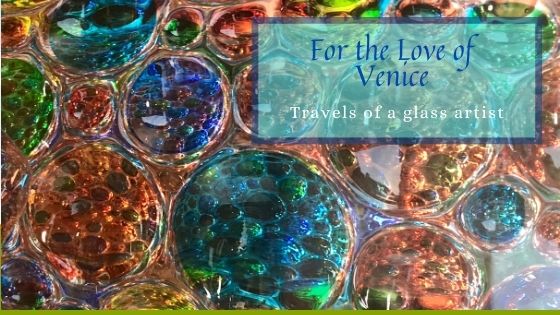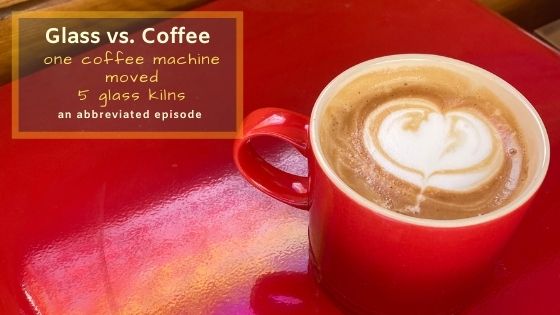A Fun Interview with Helga Stassen - glass artist, architect, lecturer, mother, farmer, traveler.

- How did you get into glass?
I’ve always loved glass and coloured light. When I was a lecturer in Construction at the Department of Architecture, Pretoria University, my favourite lecture, by far, was the one I presented on glass. But on a hands-on-glass level, one day in 2009 I walked past a small little glass shop in Pretoria, walked in, signed up for a course and got hooked on day one. Hungry to know more I went to Portland, Oregon in the US for two more courses at the Bullseye factory and a year later to Italy for do advanced techniques in fusing with Miriam di Fiori.

As my little home studio grew, my career as an architect flew out the window and my company Glass Roots was born. That’s the short version!
- Why glass?
Because it is magical and addictive and enchanting and technical and colourful and difficult and rewarding and timeless and it resonates with my soul.
- Tell us about the process you use in making these beautiful glass products…
I fuse glass, this means I melt glass pieces or glass powder together in a glass kiln, hence the term kilnformed glass. It is mostly a flat process with a front and a back. To make something like a bowl the glass can then be slumped in a second firing in a mould. One can also cast glass in a mould to make sculptures. It is possible to make a wide variety of glass works -large architectural panels and installations, artworks, vessels, jewellery, lights, decor pieces and sculptures, each of these requiring a slightly different process in the kiln. With all the many options there is never a dull moment!
- Which, if it’s possible to select, is your favourite glass product you make, and why?
Not an easy one because I like variety and enjoy so many of the processes to make each product! I love to pack the little pieces of millefiori to make jewellery as they have done for so many years in Venice and it connects me to that tradition. I love to grind a piece after it has been fired because with this process the glass becomes more perfect and finished, elevating the work already done to a higher level. I love doing big projects as the professional architect in me wakes up and runs with it. I like ‘drawing’ with dry glass powder as this is close to painting, something I’ve always loved to do as well. And then there’s the big saw! Working with big power tools is totally cool!
- Which is your least favourite glass product to make, and why?
Other people’s corny ideas! I am working hard on my skill to avoid these types of projects without insulting the person who requested it!
- How/where do you get your raw materials?
All coloured art glass is imported. I work mainly with two types of glass - Bullseye glass which I import from the States and Italian Murano glass. Bullseye offers a wonderful variety in glass materials and really are the front leaders in kiln glass development and excellence. Then there’s this lovely place in Italy called Murano, one of the Venetian islands and I love having a constant business excuse to go there. Going there in person gives me the opportunity to select unusual things and to wander for hours in alleys filled with glass shop upon glass shop. I’m working on putting together tours to Italy for a wonderful glass experience and you’ll even have an architect as a guide! Any takers?
- What makes you a glass artist?
I eat, sleep, breathe, think, live glass. Simple.
- Who is your favourite glass artist?
Hmm, there are quite a few! I’m a big fan of glassblowing maestro, Lino Tagliapietra. I was lucky to meet him in Murano and spend two hours with him showing me his private gallery and studio. He is a beautiful and humble soul and still blowing amazing glass at 85! He is an inspiration to many glass artists all over the world.
Maestro Lino with his private collection in Murano.
In the world of kilnformed glass I like Klaus Moje (the father of kilnwork), Karl Harron (alchemist!), April Surgent (been to Antarctica like me and draws inspiration from there), Nathan Sandberg (he hosted the courses I took at Bullseye), Miriam di Fiori (a powerhouse of technique and inspiration, I’ve learnt so much from her teaching), Richard Parrish (ex-architect like me). And many more!
- How long does it take for you to make a pendant?
Too long actually! But it depends... not all pendants are created equal. It really depends on a variety of factors – the type of technique used, the complexity of the design, the amount of times it gets fired and reworked, the size and so on. On top of all that, sometimes the glass just has its own will which can then take even longer or worst case scenario, make me start all over again. I make pendants in batches, finishing one process at a time rather than complete one pendant at a time. Most pendant processes involves cutting sheet glass and grinding it to shape, placing glass components in position with a tweezers and them melting it together. Once cooled down and cleaned, then follows the cold-working processes of grinding the glass into shape, drilling holes and firing the pieces for a second time. Some pendants involve a sawing process and some others are fired three times. The process of attaching the sterling silver bits, polishing and cleaning and then pricing and display also adds up to the total amount of production time. Most pendants are fired at least twice, so they spend about 25-28 hours in the kiln in total.
- What are your future plans for Glass Roots?
I have so many exciting plans! We are working towards expanding the online shop into a glass emporium with a variety of beautiful glass and glass-inspired products. On the farm Kalanderkloof where the glass studio is located we have some plans to develop a glass sculpture garden and offer tours to view the artworks, sell from the little shop and people can enjoy our colour café under the trees overlooking the forest. The sculpture garden will showcase some exciting glass ideas, including recycled glass but I am not letting the cat out of the bag just yet. I’m also working on some research material to be used for sensory retreats and there’s even a movie growing behind the scenes!
- If you could choose to be a colour in glass, which colour would you be and why?
I think as I am a rather complex person, I’ll have to opt to be a sheet of Bullseye reactive ice clear glass with a rainbow iridescent layer fused onto cyan opalescent glass with some bits silver and gold leaf somewhere in between. Or when I grow up I could transcend and just be pure crystal-clear faceted transparent!
- Do you involve your children in the studio?
It’s rather a case of the kids involving themselves in the studio and me trying my best to roll with it! If possible, I help them to bring their own ideas to life and both of them have made some jewellery that has sold at the market! My daughter is an apprentice with great potential and my son enjoys using the grinder to file his nails!
- Tell us about your studio cat?
Dear little Lala is a joy! She arrived as a dainty, black kitten last year and has been quite the socialite in the studio. She flirts with everybody, regulars and visitors alike and she loves glass. She often displays herself on a shelf but mostly, being so girly, loves jewellery. We had one padded timber box specifically for extra studs (not the male type) but we have had to remove all the earrings and she now curls up in here most of the day. She has a few other secret hiding places and pops out giving us a fright!
- Is there a studio dog, elephant, porcupine?
Elephant, not yet – I’m sure I’ll see one on the farm one day! But yes, there are dogs, one big Alex and one small Mielie. They often lie around or just walk through the studio, it is when they chase the cat that my stress levels really hit the roof! When the dogs bark around the studio at night I know I have unwanted afterhours visitors. The porcupines and bush pigs can sometimes be rather destructive in the garden and I am now going to resort to making the whole garden full of glass flowers instead! On a very hot day we have had a snake fall out of a tree on the paving with a thump, twice in one day! We don’t really invite those in.
- Do you listen to music while you’re working in the studio….and what?
I love music and always play something to suit my mood, especially at night or when I have a serious deadline and it needs to get lively in the studio! I have diverse audio taste and it can be anything from Beethoven and Bach to Nickelback and Nirvana with Hans Zimmer, Edith Piaf and Buddha-Bar in between. Ed Sheeran, Queen, Yo-yo Ma and Bob Marley are all regular entertainers and the playlists are ever expanding. When we host Open Studio days we play some gentle piano background music and when the kids are messing about there’s even the occasional Disney theme songs to get silly with.
- What is the funniest thing that has happened in the studio?
Once one gets over the initial shock and disappointment, flops from the kiln can be very endearing or even funny to play with. For example, in an instant a showpiece glass bowl can become a helmet!

- What is the worst thing that has happened in the studio?
The worst moments in the studio have been when technical issues caused damage to my kilns. I have lost one kiln completely including the imported moulds and all the glass inside, thanks to a power surge. The controller went mad and did not stop heating, the glass evaporated!
Another kiln was damaged badly and I lost a whole batch of really special jewellery pieces, a day before a show! Other than that glass things slip, drop, crack or devitrify but luckily no explosions yet!
- How much do you enjoy answering interview questions such as this one?
Banana
- What is the one question you wished was in this interview?
What’s the biggest glass creation you were ever involved in?
- Go on and answer that question!!
In a previous chapter of my life I was an architect and designed the new Scientific Research Base on Marion Island, a South African-owned group of islands halfway to Antarctica.

It was a huge building constructed with GRP panels – glass reinforced plastic better known as fibre glass. All 4500m² of fibre glass and double-glazed windows makes this building quite a large glass baby that was part of my life for almost 10 years! But this topic is probably worth a whole separate questionnaire and as I’ve said – Banana!
Leave a comment
Comments will be approved before showing up.
Also in For the Love of Glass

For the Love of Venice

Glass vs Coffee



